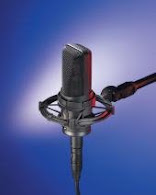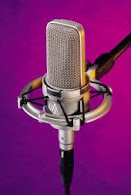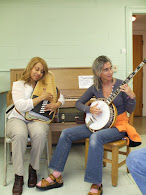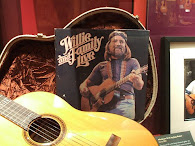
Sunday, May 23, 2010
How to Get Hardtune Effects

Sunday, May 16, 2010
Custom Pedal Boards vs BOSS GT-10

Which is best? Stomp box effects or a multi-effector like the BOSS GT-10? If you are gigging a lot this summer, here's how to make the call. Left Keeley's Fuzz Head and Digitech's - Scott Ian Signature multi effect pedal.
One of the main travel issues bands have to contend with is portability and weight. My acoustic rig consists of: A Fender Passport PD-500, (mixer is built in), an Audio-Technica Wireless Guitar System & AE5400 condenser vocal mic, Fender Wireless Headworn Mic, BOSS Dr. 3 Drum & Bass Machine, T.C. Helicon mic preamps, Martin D-16 and HD-28 acoustic guitars with pick ups, Autoharp with pickup.
My electric rig hauls a: Tech21 NYC Trademark 60 guitar amp, Fender Stratocaster, Keeley Fuzz Head, Keeley Compressor, BOSS Digital Delay, Ibanez WD-7 Wah Pedal OR the BOSS GT-10 with the same mics and sound support systems as listed above. So you can see that I can get most of all the same effects and more in the signal chain that I wish with the BOSS GT-10.
Still there is a place for home grown pedal boards. Most bands either have them custom made or set them up themselves such as the one here below by Jon Falk, a guitarist for the band 40Winx.
 Home Grown Pedal Boards
Home Grown Pedal Boards
You can see here that Jon has his pedals in the order he prefers and spaced for easy access during the set. The Volume pedal is over on the left but many guitarists have their Wah / Volume pedals on the opposite side of the board on the right. Still this is the beauty of making your own. One size does not fit all and this guitarist's preferences come first. The result? Mr. Falk was hitting his switches with ease and confidence throughout the concert. This band does many classic rock covers from the Beatles to Fleetwood Mac to Neil Diamond to the Black Crowes. When you have to cover that many styles, these pedals are almost a necessity to capturing the original "tone" of the guitar leads. With out them, a cover band could not pull off the "flavor" of the song they are trying to recreate.
 BOSS GT-10 Multi-Effector
BOSS GT-10 Multi-Effector
The BOSS GT-10 offers some of the same options as a custom or hand made pedal board. For example, you can order the pedals in a specific sequence or allow BOSS to do it for you by using one of the factory presets. Notice too that the volume/expression pedal is over on the right. If that is not to your liking, well you're sort of stuck with it!
Another thing that I noted with the BOSS GT-10 is that while many of the 400 + presets are good, they will often vary in volume. You'll be playing Texas Crunch and then switch to another preset and have a huge drop off in volume. So switching effortlessly between presets as shown in the BOSS videos is really just hype. Some of the presets are so much hotter than the others that they can cause major feedback should you want to plug in an acoustic. This even happens when you are trying the ultra clean channels.
The Wrap
You really have to judge for yourself which option is best. I like the fact that the GT-10 is a all-in-one multi-effector with more cabinets, amps, modeling and effects than I'll ever use. Still, it has its limitations. If you can keep it clean and sweet, I would recommend building your own pedal board for the road and powering it with a Voodoo Lab Pedal Power II. This will mean, no surprises and you will most likely be more comfortable finding and hitting the switches you yourself have put in place. Read our down and dirty article on how to build your own pedal board with tips on sequencing your pedals right here: Guitar Pedals Get the Effect & check this video below showing some of the features of the BOSS GT-10.
My electric rig hauls a: Tech21 NYC Trademark 60 guitar amp, Fender Stratocaster, Keeley Fuzz Head, Keeley Compressor, BOSS Digital Delay, Ibanez WD-7 Wah Pedal OR the BOSS GT-10 with the same mics and sound support systems as listed above. So you can see that I can get most of all the same effects and more in the signal chain that I wish with the BOSS GT-10.
Still there is a place for home grown pedal boards. Most bands either have them custom made or set them up themselves such as the one here below by Jon Falk, a guitarist for the band 40Winx.
 Home Grown Pedal Boards
Home Grown Pedal BoardsYou can see here that Jon has his pedals in the order he prefers and spaced for easy access during the set. The Volume pedal is over on the left but many guitarists have their Wah / Volume pedals on the opposite side of the board on the right. Still this is the beauty of making your own. One size does not fit all and this guitarist's preferences come first. The result? Mr. Falk was hitting his switches with ease and confidence throughout the concert. This band does many classic rock covers from the Beatles to Fleetwood Mac to Neil Diamond to the Black Crowes. When you have to cover that many styles, these pedals are almost a necessity to capturing the original "tone" of the guitar leads. With out them, a cover band could not pull off the "flavor" of the song they are trying to recreate.
 BOSS GT-10 Multi-Effector
BOSS GT-10 Multi-EffectorThe BOSS GT-10 offers some of the same options as a custom or hand made pedal board. For example, you can order the pedals in a specific sequence or allow BOSS to do it for you by using one of the factory presets. Notice too that the volume/expression pedal is over on the right. If that is not to your liking, well you're sort of stuck with it!
Another thing that I noted with the BOSS GT-10 is that while many of the 400 + presets are good, they will often vary in volume. You'll be playing Texas Crunch and then switch to another preset and have a huge drop off in volume. So switching effortlessly between presets as shown in the BOSS videos is really just hype. Some of the presets are so much hotter than the others that they can cause major feedback should you want to plug in an acoustic. This even happens when you are trying the ultra clean channels.
The Wrap
You really have to judge for yourself which option is best. I like the fact that the GT-10 is a all-in-one multi-effector with more cabinets, amps, modeling and effects than I'll ever use. Still, it has its limitations. If you can keep it clean and sweet, I would recommend building your own pedal board for the road and powering it with a Voodoo Lab Pedal Power II. This will mean, no surprises and you will most likely be more comfortable finding and hitting the switches you yourself have put in place. Read our down and dirty article on how to build your own pedal board with tips on sequencing your pedals right here: Guitar Pedals Get the Effect & check this video below showing some of the features of the BOSS GT-10.
Eclectic Sound TV's HD Video Demo of the BOSS GT-10
Saturday, May 8, 2010
Martin HD-28 Review

C.F. Martin's HD-28 on stage at the Corner Cafe. Levy's Leathers Platinum Collection Guitar Strap. Hercules Tilt Base Mic Stand.
Up until now, I have been performing with my Martin D-16GT which has a solid spruce top and mahogany back and sides. Like my HD-28, I had a Fishman Ellipse Matrix Blend under the saddle pickup installed at the Martin Factory. This pickup system does not require cutting into the guitar, preserving its beauty and function as an acoustic. The Matrix Blend allows you to combine and adjust the under the saddle pickup with the mic pic up to suit your playing needs. With my D-16, I switched to light Martin Acoustic strings because with my guitar amp, I found that the bassiness of the medium strings caused too much feedback.
The Martin HD-28 has a solid Sitka spruce top and rosewood back and sides. It is a full gloss guitar with beautiful herringbone binding and purfling down the back. However, where it shines is in the sound. This is a powerhouse instrument. Acoustically, it can easily fill a room without an amp. With an amp, (I use a vintage USA made Crate GX-20M on the road and a Tech21 Trademark 60 in the studio), it truly stands out with all its multi-tones. I simply choose the cleanest possible channel and adjust from there. The HD-28 is such a powerful and
 loud guitar due in part to the scalloped X-bracing invented by C.F. Martin. This lighter, sculpted bracing allows the soundboard to vibrate much more freely, making the HD-28 sound quite "opened up" over its D-28 brother.
loud guitar due in part to the scalloped X-bracing invented by C.F. Martin. This lighter, sculpted bracing allows the soundboard to vibrate much more freely, making the HD-28 sound quite "opened up" over its D-28 brother.
I found that on stage, I needed to back off of the strumming and picking a bit. The amp just reads that as too much gain but since I also play this guitar acoustically, changing to lighter strings is not an option. I also turned off the chorus. This guitar has plenty of "chime" without adding that effect. All in all I would recommend backing off the volume or gain on your guitar and amp for the cleanest tones. Otherwise you may end up with unwanted distortion and feedback.
I use a Medium Martin Tortoise Pick and a Planet Waves Dual Action Capo & Custom Pro Series Cables with the HD-28. I find that the PW Capo does not pull the guitar out of tune and their cables are superior for quietness. I packed the HD-28 in my Martin Gig Bag (SEE this REVIEW) which was much lighter than the hardshell case and easier to transport to the stage area. Actually, everything got carried in one trip. I was very impressed playing my Martin HD-28 for the first time in concert and am looking forward to using it again at my next gig with these adjustments. A true cannon!
The Martin HD-28 has a solid Sitka spruce top and rosewood back and sides. It is a full gloss guitar with beautiful herringbone binding and purfling down the back. However, where it shines is in the sound. This is a powerhouse instrument. Acoustically, it can easily fill a room without an amp. With an amp, (I use a vintage USA made Crate GX-20M on the road and a Tech21 Trademark 60 in the studio), it truly stands out with all its multi-tones. I simply choose the cleanest possible channel and adjust from there. The HD-28 is such a powerful and
 loud guitar due in part to the scalloped X-bracing invented by C.F. Martin. This lighter, sculpted bracing allows the soundboard to vibrate much more freely, making the HD-28 sound quite "opened up" over its D-28 brother.
loud guitar due in part to the scalloped X-bracing invented by C.F. Martin. This lighter, sculpted bracing allows the soundboard to vibrate much more freely, making the HD-28 sound quite "opened up" over its D-28 brother.I found that on stage, I needed to back off of the strumming and picking a bit. The amp just reads that as too much gain but since I also play this guitar acoustically, changing to lighter strings is not an option. I also turned off the chorus. This guitar has plenty of "chime" without adding that effect. All in all I would recommend backing off the volume or gain on your guitar and amp for the cleanest tones. Otherwise you may end up with unwanted distortion and feedback.
I use a Medium Martin Tortoise Pick and a Planet Waves Dual Action Capo & Custom Pro Series Cables with the HD-28. I find that the PW Capo does not pull the guitar out of tune and their cables are superior for quietness. I packed the HD-28 in my Martin Gig Bag (SEE this REVIEW) which was much lighter than the hardshell case and easier to transport to the stage area. Actually, everything got carried in one trip. I was very impressed playing my Martin HD-28 for the first time in concert and am looking forward to using it again at my next gig with these adjustments. A true cannon!
| MODEL | HD-28 |
| CONSTRUCTION: | Mahogany Blocks/Dovetail Neck Joint |
| BODY SIZE: | D-14 Fret |
| TOP: | Solid Sitka Spruce |
| ROSETTE: | Style 28 |
| TOP BRACING PATTERN: | Standard ''X'' Scalloped |
| TOP BRACES: | Solid Sitka Spruce 5/16'' |
| BACK MATERIAL: | Solid East Indian Rosewood |
| BACK PURFLING: | HD Zig-Zag |
| SIDE MATERIAL: | Solid East Indian Rosewood |
| ENDPIECE: | White Boltaron |
| ENDPIECE INLAY: | Black/White Boltaron |
| BINDING: | White Boltaron |
| TOP INLAY STYLE: | Bold Herringbone |
| SIDE INLAY: | none |
| BACK INLAY: | Black/White Boltaron |
| NECK MATERIAL: | Select Hardwood |
| NECK SHAPE: | Low Profile |
| NUT MATERIAL: | Bone |
| HEADSTOCK: | Solid/Diamond/Square Taper |
| HEADPLATE: | Solid East Indian Rosewood /Raised Gold Foil |
| HEELCAP: | White Boltaron |
| FINGERBOARD MATERIAL: | Solid Black Ebony |
| SCALE LENGTH: | 25.4'' |
| # OF FRETS CLEAR: | 14 |
| # OF FRETS TOTAL: | 20 |
| FINGERBOARD WIDTH AT NUT: | 1-11/16'' |
| FINGERBOARD WIDTH AT 12TH FRET: | 2-1/8'' |
| FINGERBOARD POSITION INLAYS: | Style 28 |
| FINGERBOARD BINDING: | none |
| FINISH BACK & SIDES: | Polished Gloss |
| FINISH TOP: | Polished Gloss ; Sunburst available at additional cost. |
| FINISH NECK: | Satin |
| BRIDGE MATERIAL: | Solid Black Ebony |
| BRIDGE STYLE: | Belly |
| BRIDGE STRING SPACING: | 2-1/8'' |
| SADDLE: | 16'' Radius/Compensated/Bone |
| TUNING MACHINES: | Chrome Enclosed w/ Large Buttons |
| RECOMMENDED STRINGS: | Martin Studio Performance Medium Phosphor Bronze (MSP4200) |
| BRIDGE & END PINS: | White w/ Black Dots |
| PICKGUARD: | Tortoise Color |
| CASE: | 640 Molded |
| INTERIOR LABEL: | none |
| ELECTRONICS: | Optional |
| OTHER OPTIONS: | Available left-handed at no additional charge |
Congratulations to ANGIE M. of N.Y. the WINNER of our MAY Guitar Gear Give-Away!!! Be sure to check our listings below for upcoming SHOWS, JAMS and OFFERS this summer!
Saturday, May 1, 2010
C.F. Martin's Gig Bag

Get your kicks on Route 66! C.F. Martin's 52BGB Dreadnought Gig Bag hits the road in this classic 1964 Mercury Caliente. Western Concho Hat by Dorfman Pacific.
Review of C.F. Martin's 52BGB Dreadnought Gig Bag. List $85.00, Street $69.00
Now that the weather is warmer, you'll be taking more road trips with your favorite acoustic guitar. The Dreadnought shape and design was actually invented by C.F. Martin & Co. Guitars and it is still a staple of many folk, country and western artists. The obvious reason why "dreads" are so popular is that they are loud enough not to require amplification. This makes them the best "unplugged" travel companions for picnics, beach parties and barbecues.
Depending on your travel arrangements, you might choose to pack your guitar in a lighter, easier to carry gig bag as shown above. The plus in using such a bag is the large outer zippered pocket that allows taking along sheet music and other larger items too big for a hardshell's storage compartment. These bags are good for traveling in a car or where you will be in control of your instrument.
Not all gig bags are alike though. I would recommend a Levy's heavy denim or leather gig bag for any solid body electric such as a Fender Strat or Gibson Les Paul. I have found Levy's to be extremely well made and richly padded.
Likewise the C.F. Mar tin 52BGB Logo Gig Bag is very well made. This gig bag is constructed of a tough nylon ballistics cloth exterior which resembles black denim with thick foam padding inside to protect your Dreadnought. I especially like the heavy double zipper pulls but wish they had put them on the outer pouch as well. All the same, this is a superior gig bag in style and features, worthy of your C.F. Martin or other beloved acoustic. The classic C.F. Martin logo is embroidered across the outside pocket in gold thread and the bag is reinforced at all the major stress points for extra strength. While it may not be a replacement for the safety of a hardshell case, it offers quite a bit more protection than the average gig bag being sold for acoustics.
tin 52BGB Logo Gig Bag is very well made. This gig bag is constructed of a tough nylon ballistics cloth exterior which resembles black denim with thick foam padding inside to protect your Dreadnought. I especially like the heavy double zipper pulls but wish they had put them on the outer pouch as well. All the same, this is a superior gig bag in style and features, worthy of your C.F. Martin or other beloved acoustic. The classic C.F. Martin logo is embroidered across the outside pocket in gold thread and the bag is reinforced at all the major stress points for extra strength. While it may not be a replacement for the safety of a hardshell case, it offers quite a bit more protection than the average gig bag being sold for acoustics.
Gig bags also give you more freedom to carry other items such as a stool or even an extra instrument. This is due to the backpack type straps. Slip the straps on your shoulders and your hands remain free or turn it on its side and tote it by the leather reinforced carrying handles. The bag is finished off with slip resistant resin feet. With a gig bag like this, you'll appreciate the lighter, breezier way to travel with your guitar this summer! For more gig bag & guitar case options, check out Eclectic Sound's BEST Gig Bags & Cases
PHOTO: C.F. Martin Special Edition Sustainable Series Dreadnought in Cherry, SWDGT. Handmade Guitar strap by Sully's Leather Straps.
Now that the weather is warmer, you'll be taking more road trips with your favorite acoustic guitar. The Dreadnought shape and design was actually invented by C.F. Martin & Co. Guitars and it is still a staple of many folk, country and western artists. The obvious reason why "dreads" are so popular is that they are loud enough not to require amplification. This makes them the best "unplugged" travel companions for picnics, beach parties and barbecues.
Depending on your travel arrangements, you might choose to pack your guitar in a lighter, easier to carry gig bag as shown above. The plus in using such a bag is the large outer zippered pocket that allows taking along sheet music and other larger items too big for a hardshell's storage compartment. These bags are good for traveling in a car or where you will be in control of your instrument.
Not all gig bags are alike though. I would recommend a Levy's heavy denim or leather gig bag for any solid body electric such as a Fender Strat or Gibson Les Paul. I have found Levy's to be extremely well made and richly padded.
Likewise the C.F. Mar
 tin 52BGB Logo Gig Bag is very well made. This gig bag is constructed of a tough nylon ballistics cloth exterior which resembles black denim with thick foam padding inside to protect your Dreadnought. I especially like the heavy double zipper pulls but wish they had put them on the outer pouch as well. All the same, this is a superior gig bag in style and features, worthy of your C.F. Martin or other beloved acoustic. The classic C.F. Martin logo is embroidered across the outside pocket in gold thread and the bag is reinforced at all the major stress points for extra strength. While it may not be a replacement for the safety of a hardshell case, it offers quite a bit more protection than the average gig bag being sold for acoustics.
tin 52BGB Logo Gig Bag is very well made. This gig bag is constructed of a tough nylon ballistics cloth exterior which resembles black denim with thick foam padding inside to protect your Dreadnought. I especially like the heavy double zipper pulls but wish they had put them on the outer pouch as well. All the same, this is a superior gig bag in style and features, worthy of your C.F. Martin or other beloved acoustic. The classic C.F. Martin logo is embroidered across the outside pocket in gold thread and the bag is reinforced at all the major stress points for extra strength. While it may not be a replacement for the safety of a hardshell case, it offers quite a bit more protection than the average gig bag being sold for acoustics.Gig bags also give you more freedom to carry other items such as a stool or even an extra instrument. This is due to the backpack type straps. Slip the straps on your shoulders and your hands remain free or turn it on its side and tote it by the leather reinforced carrying handles. The bag is finished off with slip resistant resin feet. With a gig bag like this, you'll appreciate the lighter, breezier way to travel with your guitar this summer! For more gig bag & guitar case options, check out Eclectic Sound's BEST Gig Bags & Cases
PHOTO: C.F. Martin Special Edition Sustainable Series Dreadnought in Cherry, SWDGT. Handmade Guitar strap by Sully's Leather Straps.
Subscribe to:
Comments (Atom)






















































